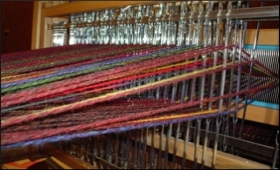|
|
|

|
Amid glitz and glamour, India's sad handloom story
|
|

|
|
| Top Stories |
 |
|
|
|
Nivedita | 20 Mar, 2013
It wouldn't be too hard to stick out in a simple white shirt and black pants amid a crowd of glamorous dresses, jazzy shirts, colourful trousers and high heels. Varanasi-based Badruddin and Hanumanta were a duo with a mission of creating awareness of the charm of India's age-old handloom work - and its growing problems.
They stood out as fashion-conscious crowds strolled, cheered and even jeered at a plethora of outfits at the exhibition area of the just-concluded Wills Lifestyle India Fashion Week (WIFW).
With as many as 128 participating designers, WIFW served as a business-to-business platform for many, and in their case, to educate people about the lost charm of handlooms.
Busy spinning the yard, they rued how the growing western culture has depleted the importance of handloom work in India and how that is the reason behind their everyday struggle for survival. "We don't get wages for the work that requires so much of hard work," Badruddin, 55, told IANS while showing the minute work that he was busy doing on the handloom machine.
"The main problem of handloom work is the market. When we take the piece to the market, we don't get a price for it. And if we don't get the money, how will we make the next piece? We need money to make new saris and we don't even get that," he added.
Hanumanta, who must be in his late 50s, agreed. "We don't get value for our hard work. We take approximately six to seven days to make a silk sari and what do we get in return? Nothing."
Both the men were part of WIFW as members of Bunkar Seva Kendra, an initiative by the textile ministry's Development Commissioner for Handlooms, who lends support to local artisans and weavers through many of their policies around the country.
At the fashion extravaganza, where designers hardly sell anything below Rs.10,000, they were glad to get queries at least.
"People came with queries, but there are more number of watchers than buyers. Most people want bling and other stylish fabrics. Who wants to go for purity? People don't understand silk any more," rued Badruddin.
They said handlooms around their village, 20 km away from Varanasi, have depleted from 1,500 to to just 50 to 60. Plus, the remuneration is not on a par with the market price of the project.
Hanumanta said the prime reason for the dismal payment is the existence of middlemen.
"They buy our pieces according to their convenience, and we are forced to sell for whatever price they want to as we need money for our livelihood... even if it means selling it at a loss," Hanumanta told IANS.
That is also the reason why they discourage their new generation to continue the trend.
"Our families have been into handlooms since generations, but we don't want our next generation to get into this. Earlier, we used to get a good amount, so we continued with this work. But now there is no money," said Hanumanta, who is also a government employee and earns a monthly income of Rs.32,000.
Even government schemes haven't been fully useful to free them of their struggle.
"The government says it has already launched several schemes for us (handloom artists), but the middleman takes the entire cost in the form of NGOs and welfare communities. We want the mediator's role to vanish. We want to get in touch with the government directly," said Hanumanta.
Even while many of noted designers like Ritu Kumar and Sabyasachi Mukherjee have been making efforts to revive the handloom sector, the plight of such weavers is sad.
On its part, the National Handloom Development Corporation Limited (NHDC), a national level agency for the promotion and development of the handloom sector, has given handloom weavers many facilities, said B.B Paul, director (Noth Zone), Weavers' Service Centre.
"We are bearing the transport cost of these weavers if they are travelling to buy yarns from other states. Also, the government has announced some bank facilities. These weavers were not getting easy access to the bank, but now things have changed," Paul said.
|
|
|
| |
|
|
|
|
|
|
|
|
|
|
|
|
|
|
| |
| Customs Exchange Rates |
| Currency |
Import |
Export |
US Dollar
|
₹88.70
|
₹87 |
UK Pound
|
₹119.90
|
₹116 |
Euro
|
₹104.25
|
₹100.65 |
| Japanese
Yen |
₹59.20 |
₹57.30 |
| As on 30 Oct, 2025 |
|
|
| Daily Poll |
 |
 |
| Who do you think will benefit more from the India - UK FTA in the long run?
|
|
|
|
|
|
| Commented Stories |
 |
|
|
|
|
|
| |
|